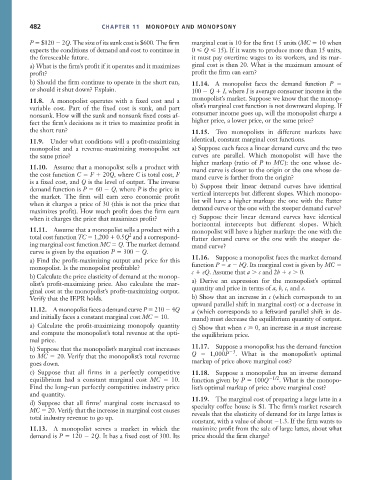Page 508 - Microeconomics, Fourth Edition
P. 508
c11monopolyandmonopsony.qxd 7/14/10 7:58 PM Page 482
482 CHAPTER 11 MONOPOLY AND MONOPSONY
P $120 2Q. The size of its sunk cost is $600. The firm marginal cost is 10 for the first 15 units (MC 10 when
expects the conditions of demand and cost to continue in 0 Q 15). If it wants to produce more than 15 units,
the foreseeable future. it must pay overtime wages to its workers, and its mar-
a) What is the firm’s profit if it operates and it maximizes ginal cost is then 20. What is the maximum amount of
profit? profit the firm can earn?
b) Should the firm continue to operate in the short run, 11.14. A monopolist faces the demand function P
or should it shut down? Explain. 100 Q I, where I is average consumer income in the
monopolist’s market. Suppose we know that the monop-
11.8. A monopolist operates with a fixed cost and a
variable cost. Part of the fixed cost is sunk, and part olist’s marginal cost function is not downward sloping. If
nonsunk. How will the sunk and nonsunk fixed costs af- consumer income goes up, will the monopolist charge a
fect the firm’s decisions as it tries to maximize profit in higher price, a lower price, or the same price?
the short run? 11.15. Two monopolists in different markets have
11.9. Under what conditions will a profit-maximizing identical, constant marginal cost functions.
monopolist and a revenue-maximizing monopolist set a) Suppose each faces a linear demand curve and the two
the same price? curves are parallel. Which monopolist will have the
higher markup (ratio of P to MC): the one whose de-
11.10. Assume that a monopolist sells a product with mand curve is closer to the origin or the one whose de-
the cost function C F 20Q, where C is total cost, F mand curve is farther from the origin?
is a fixed cost, and Q is the level of output. The inverse
demand function is P 60 Q, where P is the price in b) Suppose their linear demand curves have identical
the market. The firm will earn zero economic profit vertical intercepts but different slopes. Which monopo-
when it charges a price of 30 (this is not the price that list will have a higher markup: the one with the flatter
maximizes profit). How much profit does the firm earn demand curve or the one with the steeper demand curve?
when it charges the price that maximizes profit? c) Suppose their linear demand curves have identical
horizontal intercepts but different slopes. Which
11.11. Assume that a monopolist sells a product with a monopolist will have a higher markup: the one with the
2
total cost function TC 1,200 0.5Q and a correspond- flatter demand curve or the one with the steeper de-
ing marginal cost function MC Q. The market demand mand curve?
curve is given by the equation P 300 Q.
11.16. Suppose a monopolist faces the market demand
a) Find the profit-maximizing output and price for this
monopolist. Is the monopolist profitable? function P a bQ. Its marginal cost is given by MC
c eQ. Assume that a c and 2b e 0.
b) Calculate the price elasticity of demand at the monop-
olist’s profit-maximizing price. Also calculate the mar- a) Derive an expression for the monopolist’s optimal
ginal cost at the monopolist’s profit-maximizing output. quantity and price in terms of a, b, c, and e.
Verify that the IEPR holds. b) Show that an increase in c (which corresponds to an
upward parallel shift in marginal cost) or a decrease in
11.12. A monopolist faces a demand curve P 210 4Q a (which corresponds to a leftward parallel shift in de-
and initially faces a constant marginal cost MC 10. mand) must decrease the equilibrium quantity of output.
a) Calculate the profit-maximizing monopoly quantity c) Show that when e
0, an increase in a must increase
and compute the monopolist’s total revenue at the opti- the equilibrium price.
mal price.
b) Suppose that the monopolist’s marginal cost increases 11.17. Suppose a monopolist has the demand function
3
to MC 20. Verify that the monopolist’s total revenue Q 1,000P . What is the monopolist’s optimal
goes down. markup of price above marginal cost?
c) Suppose that all firms in a perfectly competitive 11.18. Suppose a monopolist has an inverse demand
equilibrium had a constant marginal cost MC 10. function given by P 100Q 1/2 . What is the monopo-
Find the long-run perfectly competitive industry price list’s optimal markup of price above marginal cost?
and quantity.
d) Suppose that all firms’ marginal costs increased to 11.19. The marginal cost of preparing a large latte in a
specialty coffee house is $1. The firm’s market research
MC 20. Verify that the increase in marginal cost causes reveals that the elasticity of demand for its large lattes is
total industry revenue to go up.
constant, with a value of about 1.3. If the firm wants to
11.13. A monopolist serves a market in which the maximize profit from the sale of large lattes, about what
demand is P 120 2Q. It has a fixed cost of 300. Its price should the firm charge?

